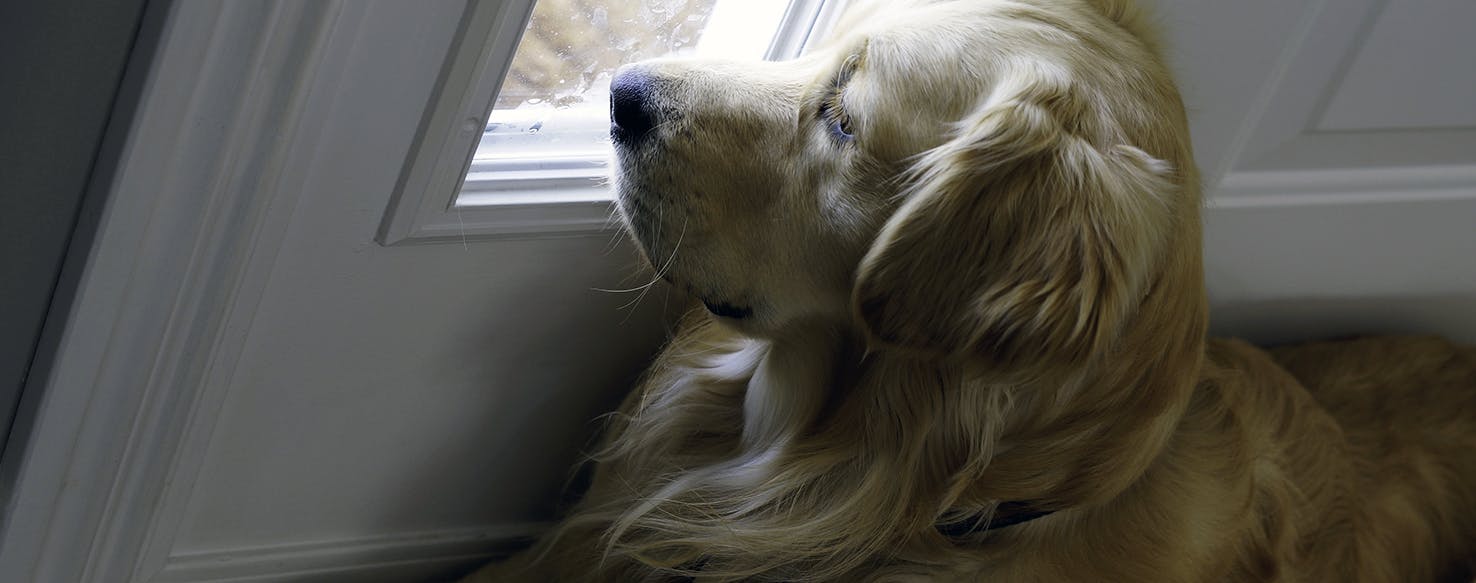- Home
- Dog Wellness
- Don't Leave Me! Separation Anxiety in Dogs
3 min read
Don't Leave Me! Separation Anxiety in Dogs

Save on pet insurance for your pet
You don't have to choose between your pet and your wallet when it comes to expensive vet visits. Prepare ahead of time for unexpected vet bills by finding the pawfect pet insurance.
Updated: 9/24/2021
Separation anxiety in dogs is not only a real condition, but it is more common than you think. According to the College of Veterinary Medicine at the University of Iowa, “Twenty to 40 percent of dogs presented to veterinary behavioral specialists suffer from this (separation anxiety) disorder.” Translation: Twenty to 40% of behavior cases are caused by separation anxiety. One main factor to remember with separation anxiety is that your dog cannot help this behavior. This behavior can include excessive barking, attempts at escape (or actually escaping), messing the house, and destruction in general. This condition can also cause physical symptoms, such as drooling, self-harm, and even ulcers. It is easy to get frustrated with your dog, but remember that they are acting this way because they love you and are anxious when you are not around. In this article, you will find several different ways to ease the anxiety of your pet while you are away.
Separation Anxiety vs. Bad Behavior
How can you tell if your pet has a true case of separation anxiety, and is not just being destructive, or misbehaving? Simply put, if your dog does not have this type of behavior when you are present, your dog probably suffers from some type of anxiety when you are away. For example, if your dog is housebroken, and he or she never messes the house while you are home, but the minute you walk out the door, your dog defecates on the floor (or couch, or your pillow), you might look more deeply into what’s going on. As in many situations, you know your dog best. If you have a gut feeling that something isn’t right, always give your dog the benefit of the doubt. If you are still uncertain, consult your veterinarian.
Setting Up a Safe Environment
Teachers in today’s society are taught to create a safe, welcoming environment in the classroom for their students. Schools have implemented this because children often feel nervous in a new place, where the environment is unknown or scary. This situation is built on much of the same idea, because although your dog lives at your house, when you leave, it can turn into a place where they do not feel loved or safe.
Make Use of the Space
Look at the area where you keep your pet while you are away. Do you lock them in a kennel? Although this technique is extremely popular in dog training, kenneling a dog with separation anxiety can make matters much worse. This can be especially true with rescue dogs, because many times, these dogs were locked up as a form or punishment or neglect. Instead, use a baby gate in a safe room with plenty of windows. Quite a bit of stress can be alleviated if your dog does not feel confined.
Make the Space Fun!
Make the time that your dog spends at home fun, or at least tolerable. Give your dog an assortment of toys that are enjoyable and keep your dog busy. There are many “busy” toys on the market today that provide dogs with hours of entertainment, you just have to find the right ones for your specific dog. Bones and chew toys are also a great way to keep your dog occupied while you are away. If have recently-worn clothes that smell like you, leave them in the room so that your dog can still feel your presence after you leave. This also tells your dog that you are, in fact, coming back for him.
Never Use Punishment
Of all the sources that describe this condition, all agree that punishment is never the answer. Providing a punishment for the behavior your dog commits during a separation anxiety panic attack leaves the dog confused and even more worried. Often times, your dog has done this hours before you get home, and does not understand what he is being punished for, because of the lack of immediate action.
Please remember, your dog is acting this way because he or she misses you and has anxiety when you are gone. Like any mental or emotional condition, your dog cannot help this behavior, and it can affect your dog physically as well. If your dog has separation anxiety, try to be patient and understanding about their situation. Look at the world from your dog’s perspective and act accordingly. Lastly, know that it is okay to leave your dog at home. Your dog will find a way to cope with their separation anxiety, you might just have to change things up a bit to help them along the way.
You may also like
